“It’s about reimagining icons and perceptions of what is beautiful—and who is beautiful.” –Elia Alba

Come with me, now I need you (2007), by Mickalene Thomas
Brains thrive and develop in distributed networks, linking rich nodes of cortical gray matter through propagating axonal threads. This process requires risks and consequences, as young brains lose cells and change connections, depending on what the environment proffers.

A top-down 3-D view of the mouse connectome. Credit: Allen Institute for Brain Science
LEARN MORE: Structure and function of complex brain networks
Years ago, celebrated neuroscientist Marian Diamond, something of a patron saint for Noggin with her passion for outreach and her hatbox containing a human brain, discovered how enrichment expanded the number of connections, with neurons sprouting dendritic spines to accommodate new synapses…
More synapses mean more potential routes for information to flow in flexible young brains, synapses which are subsequently pruned back significantly as networks solidify in response to further experience, including school. Her work spurred federal investment in Head Start, a program which promotes school readiness of young children from low-income families by providing opportunities for educational enrichment…
LEARN MORE: Office of Head Start
LEARN MORE: Response of the brain to enrichment

Colorful 3D printed Noggins at Velo courtesy of Portland 3D Printing Lab & Make + Think + Code

Newly minted M.S. and current doctoral student Emily Weiss from Psychology at Portland State University, who explores how sleep impacts African-American children entering school, and Jamaali Roberts, a recent graduate of PNCA and a talented painter using different media to rethink how Black culture is represented in American society, took the stage at Velo Cult to present intriguing research, hypnotic music, surrealistic storytelling and compelling Black art..!

“Created on their likeness,” mixed media on canvas by Jamaali Roberts

Emily is fascinated by school readiness, a multifaceted construct that incorporates the cognitive, emotional, behavioral and social skills young children demonstrate when they first go to school. How do these kids, about to enter kindergarten, acquire the skills needed to thrive in the classroom? How does sleep impact readiness? What additional factors, including bias, standardized assessments and differing cultural expectations, play a role?


LEARN MORE: Developmentally Appropriate Practice in Early Childhood Programs
Being ready for school is important for a child’s later success but, as Emily noted, academic demands are getting pushed earlier and earlier, giving children less time to develop, increasing stress, and impacting the quality and quantity of their sleep. “Being a kindergartner is tricky,” she said. “Learning behavioral expectations, acting appropriately – plus all the early math, reading and writing. Is this the new first grade?”



LEARN MORE: School readiness and later achievement
LEARN MORE: Recent trends in research on teacher-child relationships
LEARN MORE: Is Kindergarten the New First Grade?
LEARN MORE: The Life Lessons of Kindergarten Cop
There are also tremendous racial and income inequalities in the United States, exacerbated by the Great Recession of 2007 – 2009, which contribute to school readiness gaps. Public school classrooms are often “white middle class normative environments,” explained Emily, where staff and teachers aren’t fully ready to adapt to the different backgrounds and experiences of, for example, low income African-American kids…
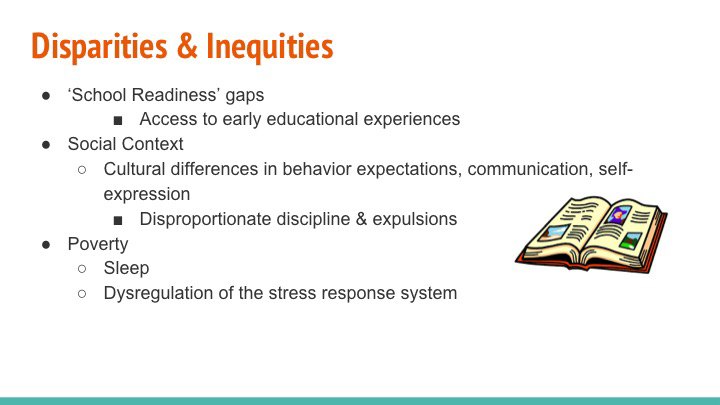

LEARN MORE: How wealth inequality has changed in the U.S. since the Great Recession
LEARN MORE: Inequality in Teaching and Schooling: How Opportunity Is Rationed to Students of Color
LEARN MORE: Racial, Ethnic, and Gender Differences in School Discipline among U.S. High School Students
A recent Noggin Velo Cult presentation by Binyam Nardos, a postdoctoral researcher at OHSU and Teressa Raiford, the founder of Don’t Shoot Portland, explored the implicit and explicit racial biases that also harm Black students and their families, increasing stress and contributing to this school readiness gap…

LEARN MORE: Race, Bias & Brain: You Can’t Control Art

Five year olds need around 10 – 13 hours of sleep per day, and inadequate rest is linked to classroom attentional difficulties. In addition, diagnosed sleep disorders are more common among kids with ADHD. Sleep deprivation may also disrupt and over-activate the stress response, leading to a familiar consequence for parents, teachers and other school staff… tantrums!

“Sleep that knits up the ravell’d sleave of care…sore labour’s bath, Balm of hurt minds, Great nature’s second course, Chief nourisher in life’s feast” –William Shakespeare
LEARN MORE: How much sleep do I need?
LEARN MORE: Sleep patterns and the risk for ADHD: a review
LEARN MORE: Sleep Deprivation and Stressors
Emily used data from a randomized control trial evaluation of an after school program (collected from 2011 – 2015, funded by the Institute of Education Sciences and the Social Innovation Fund) aiming to help kids develop social and emotional skills. The program serves predominantly low income African American students in Charleston, South Carolina…
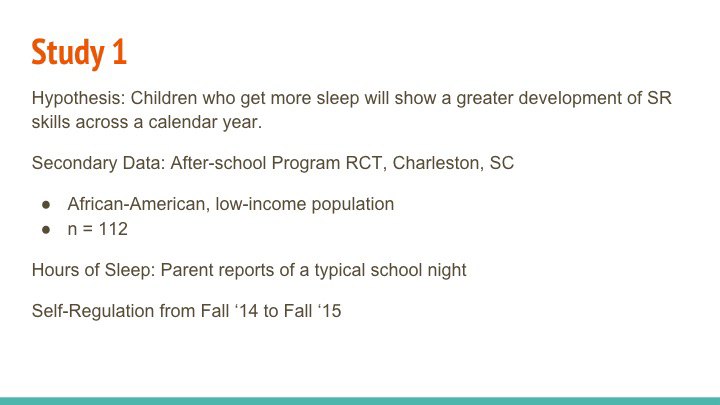

The children were tested for improvements in their working memory (the ability to hold and cognitively engage with information in the short term) and other aspects of executive function (EF), such as attention, and shifting expectations when the rules change – all skills reliant on developing networks in the brain’s frontal lobes…



LEARN MORE: Preschoolers’ Executive Function: Importance, Contributors, Research and Assessment
LEARN MORE: Predictors of early growth in academic achievement: the head-toes-knees-shoulders task
LEARN MORE: Functions of the frontal lobes: relation to executive functions
However, as often happens in research, her initial hypothesis was not supported by the data..! The amount of sleep did not directly predict the development of self-regulation, and this prompted questions. What happened? Applied research is difficult, children don’t always comply with task requirements of psychological investigations, and there are many uncontrolled personal and environmental factors in any real world classroom…


So like any good scientist, Emily came back with a new approach. How might sleep support the development of self-regulation skills in specific school contexts? Perhaps, she thought, adequate sleep could help buffer students against more chaotic, un-supportive classroom environments…


In her second study, she examined whether the effect of classroom chaos (as reported by teachers) on the development of self-regulatory skills depended on how much sleep the kids enjoyed (as reported by parents)…




Emily found a clear interaction between sleep and classroom chaos, such that kids’ development of self-regulation skills is more susceptible to the detrimental effects of classroom chaos when they get less sleep. In fact, from her data, it looks like one extra hour of sleep might fully compensate for the negative effects of an especially chaotic classroom. Sleep matters, and should be a priority for all…




“Even a soul submerged in sleep
is hard at work and helps
make something of the world.”
–Heraclitus
There were several audience questions about sleep, also one of the most popular topics in K-12 classroom outreach. We discussed some distinctive patterns of coordinated neural activity known as “sleep spindles” detectable by EEG, which are known to contribute to the consolidation of memories…
LEARN MORE: Sleep spindles in midday naps enhance learning in preschool children
LEARN MORE: Noggins in Nod
Sleep is clearly essential, and restorative, and helps everyone process and extract the “gist” of memorable daily experience and ready our brains for another day. We should prioritize sleep, and address factors (e.g., lack of inclusion) that undermine healthy slumber…

Jamaali then took the mike, and introduced himself and his fascination with art making (and music!), and with contemporary Black collage artists who inspire him with “the weird art, the trippy art, and most of all, Black art…”

“A lot of my work reflects the Black experience and how the media reflects and doesn’t include Black culture,” he explained. “Here are a few pages from the ‘Peanut Free Butter Options’ magazine I made in school – I do not like peanut butter! – collages that present the Black faces missing from the world of images we’re exposed to in American life and education…”
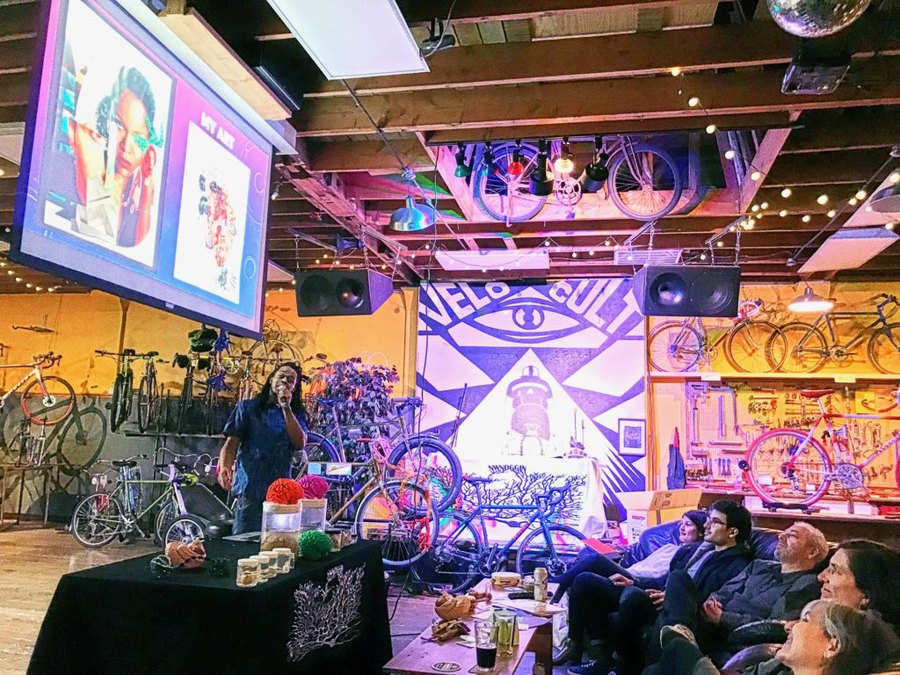

“I’m inspired all the time by people and experiences,” added Jamaali. “But some artists really move me!”

Lorna Simpson from Brooklyn, New York, is one such artist…

From Jamaali: “Lorna explores the experience of Black women in current society. She creates figures from cutout magazines, and she makes her subjects very mysterious and adaptable, showing them from behind or with their faces and eyes turned, closed, or even missing entirely.”
LEARN MORE: WHO IS LORNA SIMPSON?
LEARN MORE: Exploring Identity as a Problematic Condition

“Next we have one of my favorite collage artists, Ellen Gallagher from Providence, Rhode Island. She gets her art materials from pop culture magazines, posters, ads – especially ads for wigs and skin products targeting Black women. It’s really intricate work…”

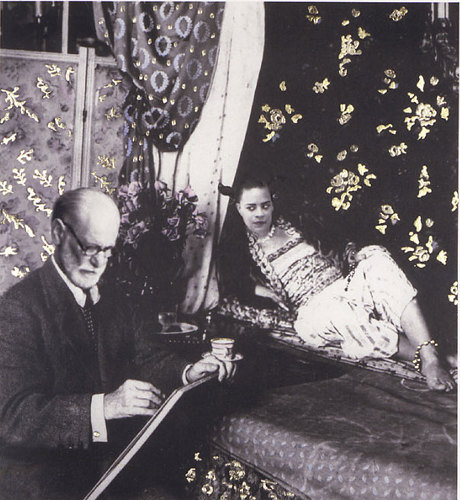
Adding missing Black faces: Odalisque (2005), Ellen Gallagher, gelatin silver print with watercolor and gold leaf
LEARN MORE: Ellen Gallagher @ art21
LEARN MORE: ELLEN GALLAGHER @ Gagosian


“Wangetchi Mutu is from Kenya. I had the pleasure of meeting her and she is amazing,” said Jamaali. “She explores what she describes as ‘the aesthetic of rejection and wretchedness’ – what stereotypes of Black women actually feel like. And she flips it around to be hopeful, powerful and sublime.”
LEARN MORE: Wangetchi Mutu
LEARN MORE: The Romantic sublime


Romare Bearden from North Carolina created more extraordinary collages during the New Negro Movement of the early 20th century. “Bearden made images of Black life in the rural and urban south,” said Jamaali. “He depicted Black experiences as universal, monumental, and with connections to Classical periods, including stories from ancient Greece…”

The Return of Odysseus (Homage to Pintoricchio and Benin) (1977)
LEARN MORE: The New Negro Renaissance
LEARN MORE: Romare Bearden Foundation



“To sleep, perchance to dream…” -William Shakespeare
“Time to create!” announced Jamaali. The Surrealist movement in art and literature sought to release the creative potential of the unconscious, including the surprising, poetic, sometimes disturbing, revolutionary and creative storytelling we often experience during sleep…
LEARN MORE: Surrealism (Metropolitan Museum of Art)
LEARN MORE: SURREALISM (Tate Gallery)

Jamaali introduced us to a popular Surrealist game known as the exquisite corpse. We folded a piece of paper in three sections, and grabbed pens off Velo tables. “I’m going to give you three minutes to draw…a sleep creature!,” exclaimed Jamaali, excitedly. “You’ll then turn the paper to the next section, with some small extension lines from your first drawing added in. You’ll pass this to your neighbor, and I’ll give everyone three more minutes to draw the next part of the creature…”


Jamaali drummed while we drew…
LEARN MORE: Exquisite Corpse (MOMA)
LEARN MORE: CADAVRE EXQUIS (EXQUISITE CORPSE) from the Tate
And he told a story of a surrealist dream…
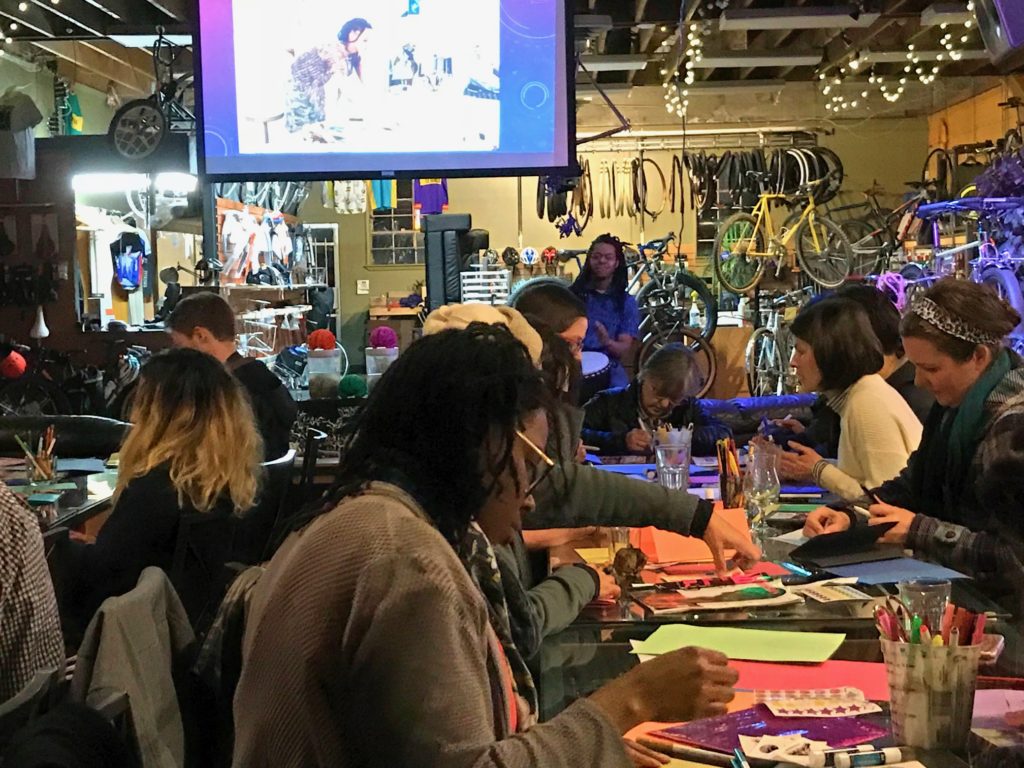


“Man is a genius when he is dreaming.” –Akira Kurosawa
The tale had many novel twists and turns, revolving around a quest for a spirit animal, and Jamaali was led into outer space, through lush forests, to deep underwater caverns and on to palm-ringed beaches recalling Tulum. He was led by a black bunny, a twenty foot tall golden gorilla with wings named Kaja, a shimmering gem-shelled turtle – and Koara, a rainbow hued multidimensional figure who told him he was loved…

Laughter, engagement, enjoyment, insight, understanding and connection were evident amidst the drawings and the drumming, the sharing and the stories, as our exquisite corpses were revealed…

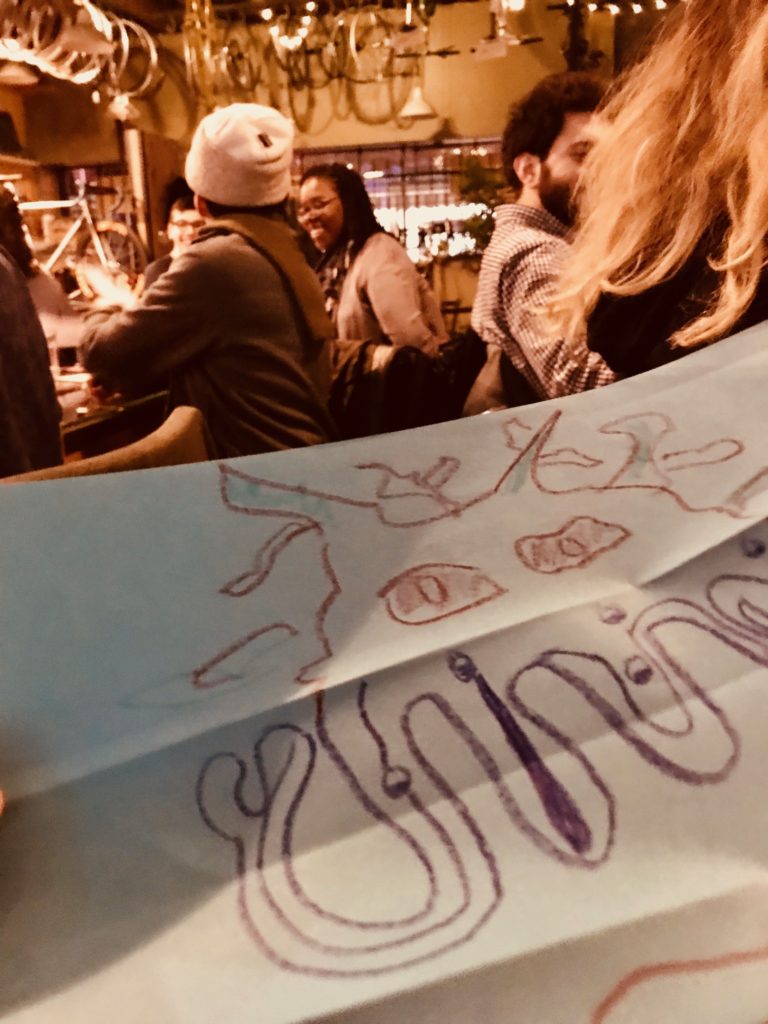



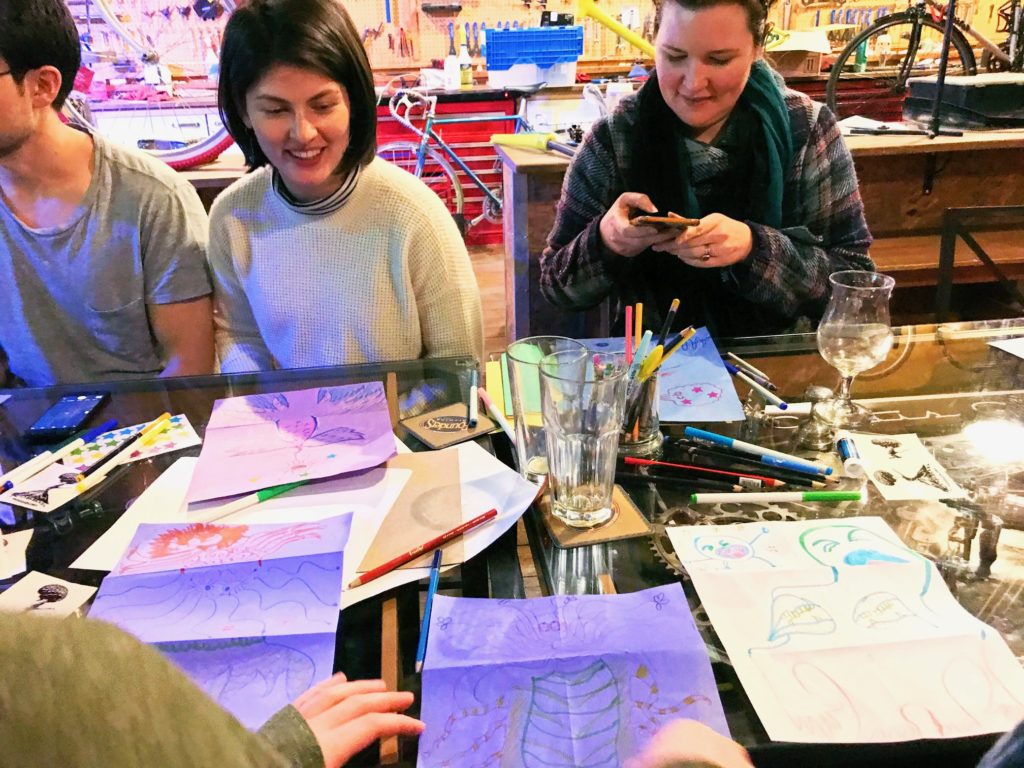

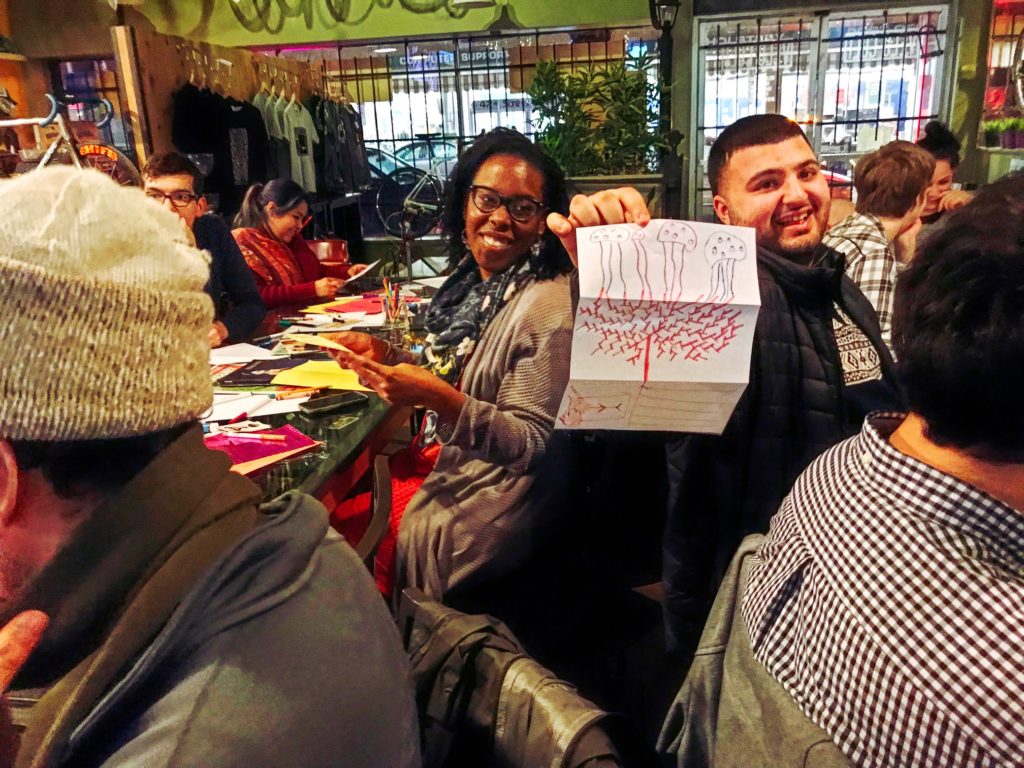


Sleep is essential. The absence of Black faces – and the faces and accomplishments of other marginalized and excluded people, including lesbian, transgender, gay, Native American, Latino, those without homes – increases stress, impacts sleep, and contributes to reduced resilience. However art is a powerful balm, bath, nourisher, a “second course” to promote inclusion and visibility – and perhaps offer more of us, including children, some vital rest…


Many thanks to Emily and Jamaali for enthusiastically sharing their research, artwork, and stories – and to Velo Cult for their generous support for public outreach and education!



